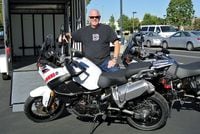Departing San Diego, California, at 9 a.m. on May 3, 1914, riding alone on a two-speed, 7-hp Indian twin, American daredevil Erwin "Cannon Ball" Baker set a transcontinental motorcycle speed record that remains impressive even today. Carrying little more than a few hand tools and a spare inner tube—no saddlebags or even a backpack—Baker battled giant sand dunes, axle-deep mud, and encounters with the US Army to arrive in New York City, 3,300 miles away, in just over 11 days. In a time before interstate highways or even paved roads, Baker's average progress of 300 miles per day was a truly remarkable feat.
Motorcycle historian Don Emde—a Motorcycle Hall of Fame member himself—had long admired Baker's accomplishments. When he heard about the inaugural 2010 Motorcycle Cannonball, a 17-day, cross-country "endurance rally" for pre-1916 motorcycles, something stuck with him. "I just noted it was going to take these riders 17 days to cover less distance on modern roads than what Baker covered in 11-and-a-half days in 1914," Emde recalls.
This got Emde thinking about Baker's run, wondering where exactly he rode, and what, if any, of that original route remained. Armed with little more than an original booklet produced by the Indian Motocycle Company in 1914 to celebrate Baker's record, Emde set out to map and recreate Baker's route as completely and faithfully as possible.
"The booklet was virtually a day-by-day journal," Emde says, "recording where he started and stopped each day." Over the next two years, as he traveled around the country on business, Emde also visited historical libraries in San Diego, Kansas City, Indianapolis, and more, studying period articles, photos, and maps to painstakingly recreate Cannon Ball's original route.
"San Diego to Phoenix was the toughest part," Emde explains. "Cannon Ball's route ran across the big dunes at Glamis up to a spot called Mammoth Wash, where he rode down the railroad tracks 50 miles to Yuma. From there he had to freelance, across the Apache Indian lands up to Santa Fe, where he picked up the historic Santa Fe Trail [as it was called then, now Interstate 25]. That led to Kansas, where he picked up the National Road [now Highway 40] across to Greensburg, Pennsylvania, where he got the Lincoln Highway [Highway 30] into Philadelphia then north to New York City."
Next, Emde started scouting the trail and linking sections together. "I tried to stay as true as I could to his route, geographically, using secondary roads and dirt roads whenever possible," Emde says. "It's actually hard to keep up with Cannon Ball's pace because he didn't have to stop at so many red lights and keep the speed limit!"
To mark the 100th anniversary, Emde led a small group of riders on the Cannon Ball Centennial Ride, leaving San Diego at 9 a.m. on May 3—100 years to the minute after Cannon Ball Baker set off on his record run. Emde's group planned to follow his route and timetable for the entire ride and arrive at Manhattan at the same time on the same day, to really experience the then-and-now of it.
"My main goal is to show what an amazing ride this guy went on," Emde says. "Here he was, riding without support, and he set a pace that's still hard to match today. Talk about an epic ride!"
Find out more about Emde's Centennial ride—and read excerpts from Cannon Ball Baker's journal—at cannonballproject.com.













/cloudfront-us-east-1.images.arcpublishing.com/octane/QSTCM6AVEZA5JJBUXNIQ3DSOF4.jpg)
/cloudfront-us-east-1.images.arcpublishing.com/octane/U4I7G625B5DMLF2DVIJDFZVV6M.jpg)
/cloudfront-us-east-1.images.arcpublishing.com/octane/B6XD6LS6IVCQPIU6HXDJSM3FHY.jpg)
/cloudfront-us-east-1.images.arcpublishing.com/octane/ICL63FEDDRDTTMINYICCEYGMDA.jpg)
/cloudfront-us-east-1.images.arcpublishing.com/octane/FCGZHQXRBZFLBAPC5SDIQLVF4I.jpg)
/cloudfront-us-east-1.images.arcpublishing.com/octane/WNOB6LDOIFFHJKPSVIWDYUGOPM.jpg)

/cloudfront-us-east-1.images.arcpublishing.com/octane/X33NU3E525ECRHXLNUJN2FTRKI.jpg)
/cloudfront-us-east-1.images.arcpublishing.com/octane/6KKT5NNL2JAVBOXMZYS5ZO76YA.jpg)
/cloudfront-us-east-1.images.arcpublishing.com/octane/J5RKG5O455GMPGQRF2OG6LRT7A.jpg)
/cloudfront-us-east-1.images.arcpublishing.com/octane/GX2CIZKQVRH2TATDM26KFG2DAE.jpg)
/cloudfront-us-east-1.images.arcpublishing.com/octane/ZWIDYSAKQZHD5BHREMQILXJCGM.jpg)
/cloudfront-us-east-1.images.arcpublishing.com/octane/CYUHJZCTSJCH3MRAQEIKXK7SCQ.jpg)
/cloudfront-us-east-1.images.arcpublishing.com/octane/LKOFINY56FCXJCANJ5M7ZDQUBY.jpg)
/cloudfront-us-east-1.images.arcpublishing.com/octane/4NBPDACMWJH63JQYJVK3QRBDZI.jpg)
/cloudfront-us-east-1.images.arcpublishing.com/octane/KKHQHRR3FJGX7H2IPU6RALMWG4.jpg)

/cloudfront-us-east-1.images.arcpublishing.com/octane/5IOFS5JAE5FOXMNA23ZRAVVYUU.jpg)
/cloudfront-us-east-1.images.arcpublishing.com/octane/CGXQ3O2VVJF7PGTYR3QICTLDLM.jpg)

/cloudfront-us-east-1.images.arcpublishing.com/octane/OQVCJOABCFC5NBEF2KIGRCV3XA.jpg)
/cloudfront-us-east-1.images.arcpublishing.com/octane/OPVQ7R4EFNCLRDPSQT4FBZCS2A.jpg)
/cloudfront-us-east-1.images.arcpublishing.com/octane/YBPFZBTAS5FJJBKOWC57QGEFDM.jpg)
/cloudfront-us-east-1.images.arcpublishing.com/octane/W5DVCJVUQVHZTN2DNYLI2UYW5U.jpg)